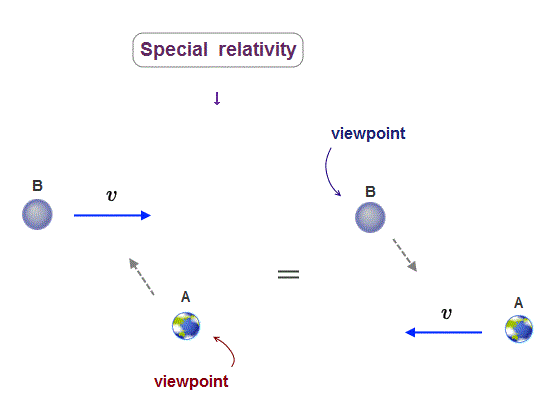
Home page
Einstein is wrong
Accelerated Rindler coordinate is unreal
(Fig.1) Seen by clock-A (or clock-B ), the other clock-B (or clock-A ) appears to be moving and ticking slower. ← Which clock-A or B ticks slower is unknown, paradoxical.

According to the unphysical Einstein special relativity (= paradoxical Lorentz transformation ), a moving clock is said to tick slower than a stationary clock. ← illusory pseudo-science
In the upper figure ①, a clock-A is moving toward a clock-B at rest. ← The moving clock-A runs slower than the stationary clock-B according to special relativity.
But from the viewpoint of the clock-A , the clock-B appears to be moving toward the clock-A, hence, the clock-B must run slower than the clock-A (= figure ② ).
↑ This means which clock A (= ① ) or B (= ② ) runs slower is paradoxical and unknown (= called twin paradox ), which shows Einstein relativistic theory is false ( this-p.5-4.conclusion ).
On this page, we show this twin time paradox is a a real fatal paradox, and can Not be solved in either special relativity (= using No acceleration, so just avoiding solving true twin paradox ) or general relativity that needs paradoxical black hole called Rindler horizon seen only by an accelerating observer.
Contrary to hypes, the paradoxical Einstein relativistic theory is useless, Not applied to any phenomena such as GPS clock time (= relativistic time dilation is too small to measure reliably, this-p.2-3,p.6-conclusion ) and illusory muon's lifetime, as shown in Sagnac effect disproving relativity.
General relativistic time dilation is illusion in gravitational redshift that can be explained by ordinary classical Newtonian energy conservation law.
(Fig.1') Seen by twin-A on the earth (or twin-B moving in the spacecraft ), the moving twin-B's clock (or twin-A's clock that appears to be moving ) runs slower, which clock of twin-A or B runs slower is paradoxical, disproving Einstein.
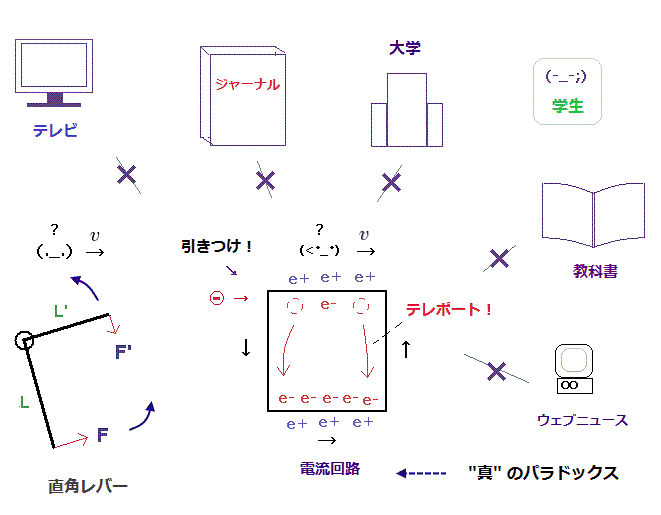
As shown in the upper Fig.1', a twin-A remains on the earth from which a twin-B departs, moves in the spacecraft, and returns to the earth.
Seen by the unmoving twin-A's clock on the earth, the moving twin-B's clock runs slower.
But as seen by the twin-B, the twin-A on the earth appears to be moving, so the twin-A's clock must run slower.
↑ Which twin-A's or twin-B's clock runs slower is paradoxical, which is called twin paradox.
The twin-B in the spacecraft must be accelerating and decelerating to return to the earth, so the frame seen by the twin-B is the "accelerating frame" that needs general relativistic (pseudo-)gravitational time dilation that is said to resolve this twin paradox ( this-2nd-last-paragraph, this p.3, p,4-(8) ).
Einstein relativity unrealistically says only an accelerating twin sees pseudo-gravitational field caused by artificial black hole called Rindler horizon ( this-p.4-3rd-paragraph ), which causes new irreparable paradox.
As a result, twin paradox is a real, unsolvable paradox ( this-p.1-abstract ) disproving Einstein relativity, contrary to an incredible amount of misleading hyped explanations including youtube ( this-p.3-left-2nd-paragraph ).
To solve the true twin paradox, we must consider the viewpoint of the accelerating twin-B in spacecraft, which needs general relativity.
But this general relativistic solution needs the unreal black hole called Rindler horizon that causes new irreparable ( time-stopping ) paradox, so can Not solve twin paradox.
So physicists started to ( wrongly ) say the special relativity without acceleration (= called inertial frame ) can resolve the twin paradox.
In these false special relativistic solutions, they use the 3rd-person moving at the constant speed instead of the accelerating twin-B, which is Not the original twin paradox ( this wrong solution-11~12th-paragraphs use the 3rd-person Albert moving at a constant speed instead of the accelerating twin Sam ).
This typical wrong special relativistic solution used the stationary twin-A's viewpoint (p.6 = Earth's RF ) and the 3rd-person's moving at the constant speed (p.7 = this RF instead of accelerating Space twin ) who sees the twin-B (= Space twin ) return to the earth at a speed higher than twin-A (= Earth twin ), so the twin-B spacecraft's clock always moving faster ticks slower.
As a result, the special relativity without acceleration also can Not solve twin paradox, and Einstein relativity is proven wrong.
(Fig.2) Clock-A on the ground runs slower than clock-B at a height of L under gravitational acceleration g according to general relativity.
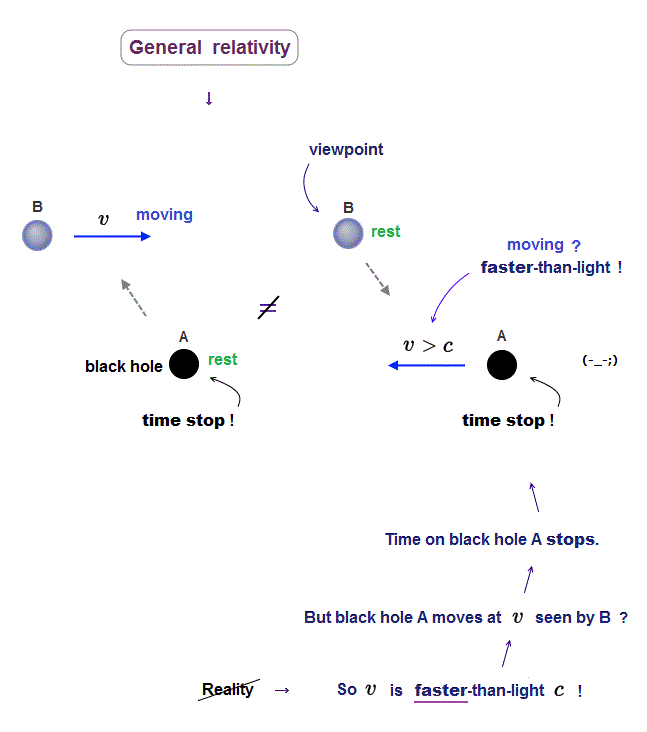
According to general relativity, clock-A on the ground (= closer to a massive star or earth ) ticks slower than clock-B at a height of L under gravity of acceleration g.
This gravitational time dilation is related to the gravitational potential (= φ = -GM/r, this p.3,p.5 ) equal to acceleration g × the distance (= height ) L = -gL (= Δφ, this p.3, this 2nd-last-paragraph ).
The problem is that this general relativistic gravitational (= acceleration ) time dilation is also paradoxical (= so wrong ), causing unreal imaginary (or negative ) time (= going backward to the past ? ) like inside an unphysical black hole, when the distance L between these two clocks is very long.
And this general relativistic gravitational time dilation based on gravitational (or acceleration ) potential causes paradoxical clock times, disproving Einstein relativity.
Gravitational redshift can be naturally explained by the ordinary classical Newtonian energy conservation law, Not by the paradoxical gravitational time dilation ( this-p.1-right-2nd-paragraph ).
As a result, twin paradox caused by a moving clock ticking slower in special relativity is a real fatal paradox that can Not be fixed by the (paradoxical) general relativity (= gravitational or acceleration time dilation )
(Fig.3) Clock-A starts to accelerate at g (= not gravity ) at the distance L from clock-B. ← This clock-A moving at a speed of v (= gt g is acceleration, t is time ) ticks slower ?
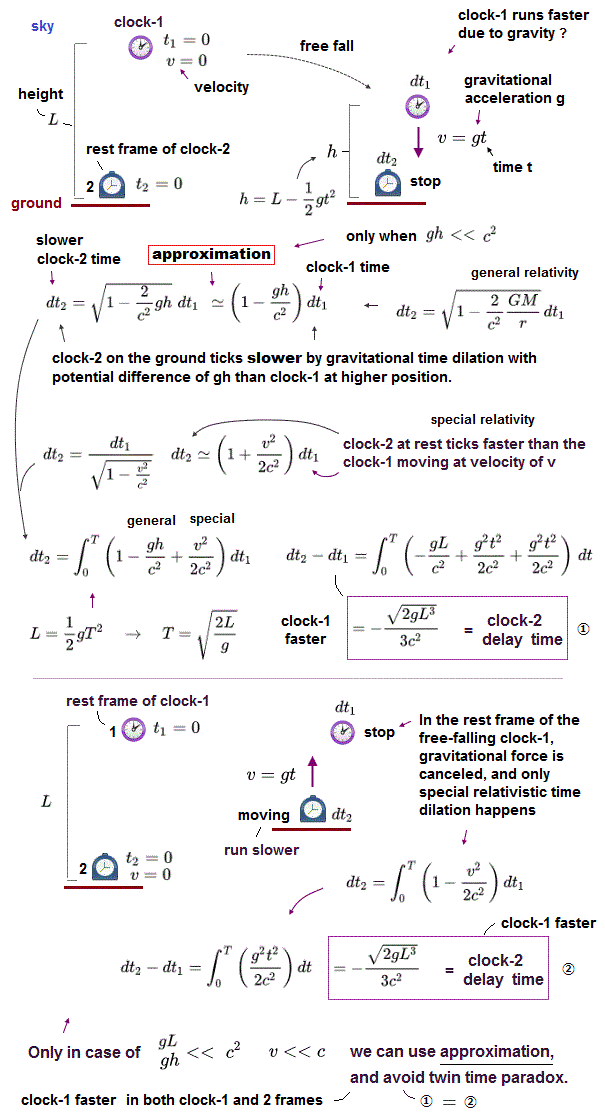
In the upper figure, a clock-A at rest starts to move or accelerate at a acceleration of g at distance L from a clock-B (= this force causing acceleration g is applied only to clock-A in this case, so No gravitational field nor no gravitational time dilation in this frame ), while the clock-B keeps stopping.
The velocity v of this clock-A at a time t is v = gt, which gives the total special relativistic time dilation of the moving clock-A by integrating it with time from t = 0 to t = T where T is the time when the clock-A reaches the clock-B (= figure.3-lower ).
↑ In this case, the moving (= accelerating ) clock-A runs slower than the clock-B at rest according to the special relativity (= no general relativity nor gravitational field is involved in this case ).
(Fig.4) From the viewpoint of the (accelerating) clock-A, clock-B appears to be accelerating toward the clock-A at fictitious gravitational acceleration of g, which causes pseudo-gravitational time dilation canceling twin paradox ?
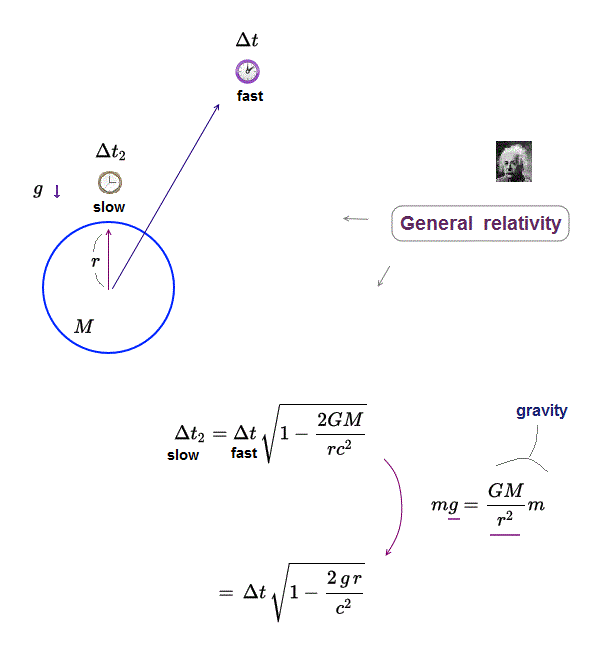
When the clock-A starts to move and accelerate (= acceleration of g ) at distance of L from clock-B toward the clock-B at rest, from the viewpoint of the clock-A, the clock-B appears to be accelerating toward the clock-A by the fictitious gravitational acceleration of g.
↑ From the viewpoint of the accelerating clock-A, all things including the clock-B appear to be accelerating at g in the opposite direction, which corresponds to the (fictitious) gravitational field influencing all things according to (unphysical) Einstein general relativistic equivalence principle.
First, as seen by the clock-A, the clock-B appearing to be moving (= accelerating ) at velocity v = gt (= t is time ) runs slower according to special relativistic time dilation (= upper figure ① ).
Second, as seen by the (accelerating) clock-A, all things appear to be accelerating at fictitious gravity (= acceleration of g ), which causes (fictitious) gravitational (= accelerating ) time dilation related to the fictitious gravitational potential = gL or gh (= L or h is distance between clocks A and B, this-(1)-lower, this p.5-upper, this p.3-lower~p.4, this-p.9 ) as shown in the upper figure ②.
↑ In this fictitious gravity (= acceleration from clock-B to clock-A ) seen by the accelerating clock-A, the clock-A at the lower fictitious gravitational potential runs slower by the amount of the fictitious gravitational potential (= - gh/c2 ) according to general relativity.
By combining these special (= moving clock-B runs slower in this ① ) and general relativistic time dilation (= by fictitious gravity in this ② ), the clock-A runs slower after all, like the clock-A moving frame (= compare the total time dilation of clock-A of the last of Fig.3 and Fig.4 which are the same. ← no twin time paradox ? ).
↑ There appears to be no (twin) paradox, because both in clock-A's moving and stationary frames, the clock-A runs slower by the same amount of time.
But this fictitious gravitational time dilation where clocks tick differently in different positions only when seen by the accelerating clock-A causes new irreparable paradox such as unreal black hole with negative time (= called Rindler horizon ).
↑ This unreal artificial black hole can Not be avoided in any accelerating frames, because the fictitious gravity (= accelerating g ) seen by some accelerating observers needs to be generated in all places (= which always generates unreal negative time black hole in places of L > c2/g from the clock-B ) to avoid twin paradox in all places.
So twin paradox can Not be resolved after all due to fictitious black hole paradoxes with negative time, and Einstein relativity is proven wrong.
(Fig.5) As seen by the accelerating clock-A, the fictitious gravity always causes paradoxical negative time in place of L > c2/g from the clock-B
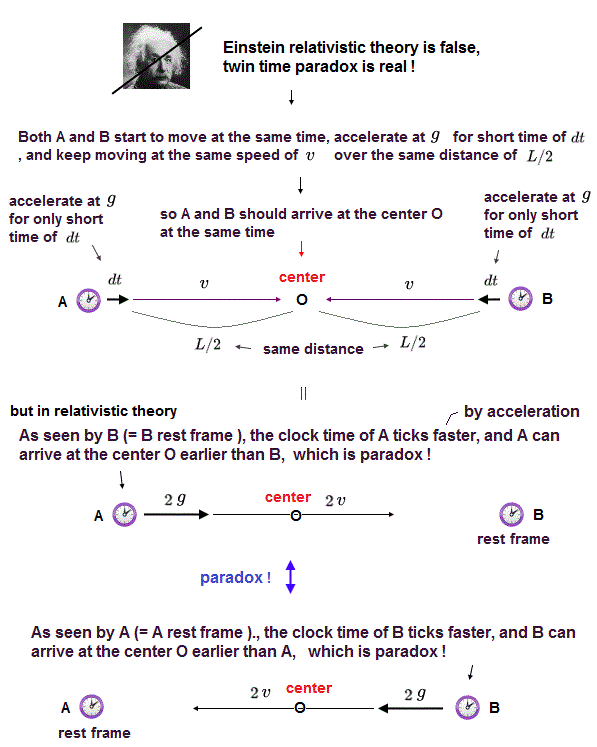
From the viewpoint of the clock-A that starts to accelerate at acceleration of g at distance L from the stationary clock-B, all things including the clock-B appear to be accelerating in the opposite direction by the fictitious gravity g.
So the clock-A runs slower than clock-B from the viewpoint of the accelerating clock-A (= clock-A's rest frame ), because clock-A is at a lower fictitious gravitational potential like on the ground.
But when the distance L between the clock-A and B is very long (= L > c2/g ), the clock-A time (= dtA ) becomes unrealistically negative, which means as the clock-B is ticking, the clock-A is unrealistically going back in time toward the past (= due to negative dtA this-middle ) like the fictitious black hole.
↑ This is clearly paradox and unphysical, which proves Einstein relativistic theory is wrong due to the artificial black hole's negative time paradox.
↑ This artificial black hole called Rindler horizon disproving Einstein relativity must always appear in places of L > c2/g from the clock-B, irrelevant to the distance between clocks A and B.
(Fig.6) Whether clock-A time stops (= like on the fictional black hole surface ) or not depends on the existence of clock-C ? ← paradox !
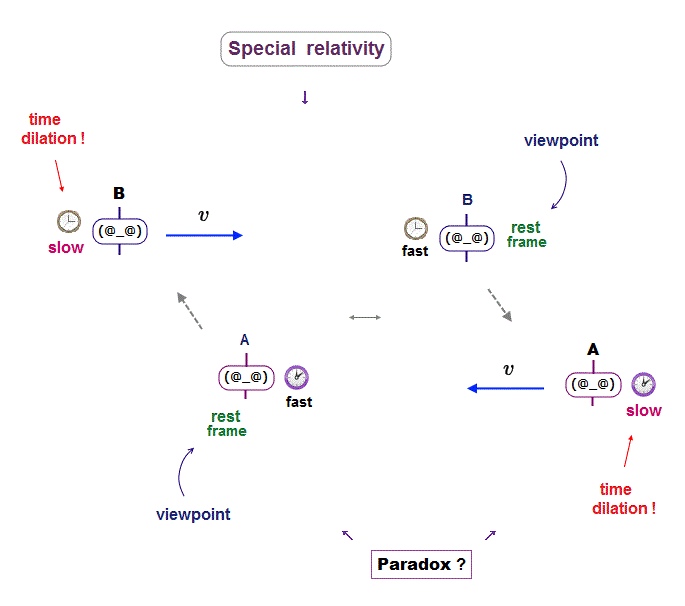
In fact, gravitational (= or acceleration ) time dilation of general relativity is paradoxical and false from the beginning.
When the distance L between clock-A and clock-B under the gravity (= or fictitious gravity by acceleration ) is equal to c2/g like in the upper figure, the clock-A's time dtA stops ( dtA = 0 ) with respect to clock-B, like on the fictional black hole.
But if we consider the clock-C (= just in the middle between clocks A and B ), the same clock-A's time does Not stop with respect to the clock-B even in the same gravitational (or acceleration ) frame, which is clearly paradox disproving Einstein relativity.
Because the distance L/2, between clock-A and clock-C (or clock-B ) is less than L = c2/g, which makes the clock-A time dtA positive, Not zero ( this figure-lower ).
This is clearly paradox, and general relativistic gravitational time dilation is also false.
(Fig.7) All clocks at rest relative to the stationary clock-B run at the same time, but when seen by the accelerating clock-A, all these clocks run at different speeds, which is paradox ↓

In the upper Fig.7, all clocks at rest relative to the stationary clock-B run at the same pace (= all these clocks always show the same time ), which can be easily confirmed by the man-C at rest with respect the clock-B (= using light detector or something ).
But when seen by the accelerating clock-A, all these clocks experience the artificial gravitational potential (= by acceleration ), hence, run at different paces in different positions with different artificial gravitational potentials (= also in the accelerated Rindler frame, clock times t in larger x' or x positions toward the right run faster with respect to the accelerating clock's A'time dt' ).
↑ This (unphysical) time difference in different clocks in different positions remains even after the clock-A stops accelerating and starts to move at the same velocity (= the accelerating clock-A sees all these clocks ticking differently, and the clock-A moving at the uniform velocity sees these clocks ticking at the same pace, but the time difference generated while clock-A is accelerating remains ).
So the man-C saying all these clocks in different positions tick at the same pace (= same time ) as seen by the stationary clock-B paradoxically says all these clocks tick at different paces (= different times ) as seen by the accelerating clock-A.
This is clearly paradox disproving Einstein relativity, which also disproves quantum mechanics.

Feel free to link to this site.